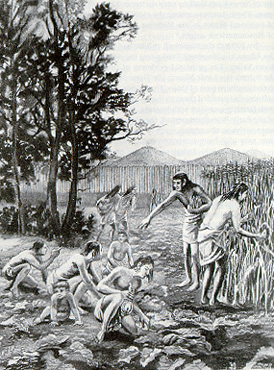

 | 11,000 BCE Native Americans first arrive in Knox County |
 | 1,000 BCE Adena Indians introduce agriculture to the area |
Who were the Adena Indians and how did they farm?
The Adena Indians used tools made of stone, animal bone, and tortoise shell to grow crops of squash, pumpkins, gourds, sunflowers and maize. The primary agrcultural product of the Ohio Indians, shortly after the introduction of agriculture to Knox County, was maize.
"What they depended on were a variety of native plants that provided relatively small seeds...And they planted these things in what we assumer were relatively small gardens and harvested those things on a regular basis. They were situating themselves where they could do farming but also would be able to go up into the hills to take some wild game and probably also a variety of different plants would be available."
 | 100 BCE Hopewell Indians largely replaced the Adena Indians |
 | Who were the Hopewell Indians? The Hopewell relied on farming as well as hunting, fishing, and gathering for food. They grew a variety of crops including squash and corn. To the left is a picture of the Hopewell Indians gathering native plants. |
| Photo from Library of Congress |
Before the arrival of white settlers, the only tools which the Indians of this area had were stone hatchets, pointed sticks, and bone shovels and hoes. After the settlers arrived, Indian agricultural began to change. The Ohio Indians of the 1700's combined methods of the Adena Indians with new methods which were influenced by white settlers. The Ohio Indians planted corn, their largest crop, in May. They would first soak the kernels in water and then plant them in holes three or four feet apart. Ohio Indians also relied on beans, nuts, and wild fruits for their diet. The Indian tribes would abandon their land every five or ten years, despite the difficulty of clearing new land, because they believed that overusing the land would ruin the soil. This method may have been the first form of rotational farming in the area.
 | 1825 The Native American population was rapidly decreasing in Knox County |
 | 1842 Native Americans were almost entirely out of the Knox County |
Although there are very few Native American farmers left in Ohio, there are still farmers of different ethnicities. For instance, there are still African American farmers in Knox County.
How much did you learn about Native American Farming?
| What was the primary agricultural product of the Ohio Indians? | |
| Which Indians replaced the Adena in Knox County? | |
| Who were the first rotational farmers in Knox County? What did they do that made them rotational farmers? | How did Native American tools change from the Adena to later Native Americans? |


